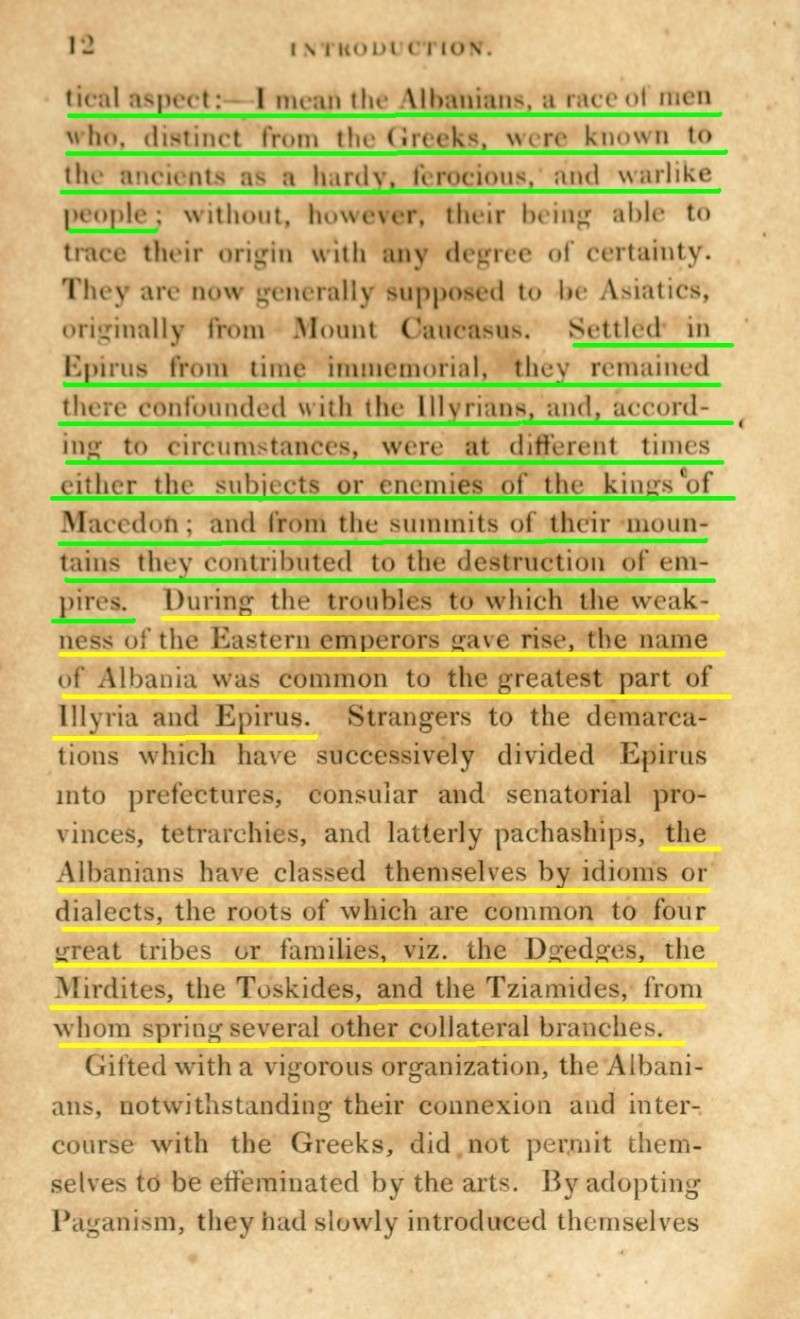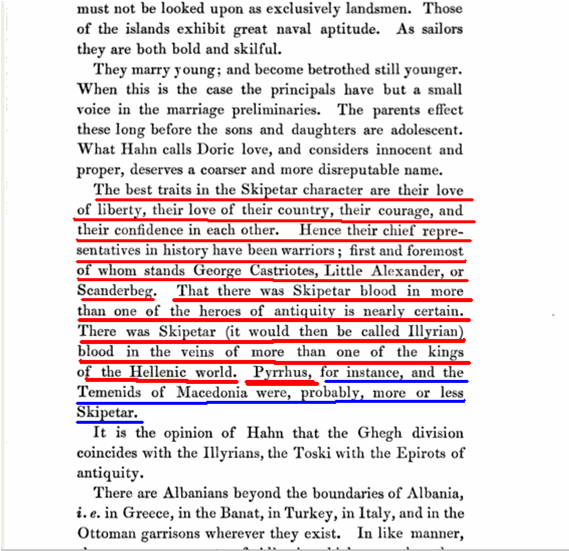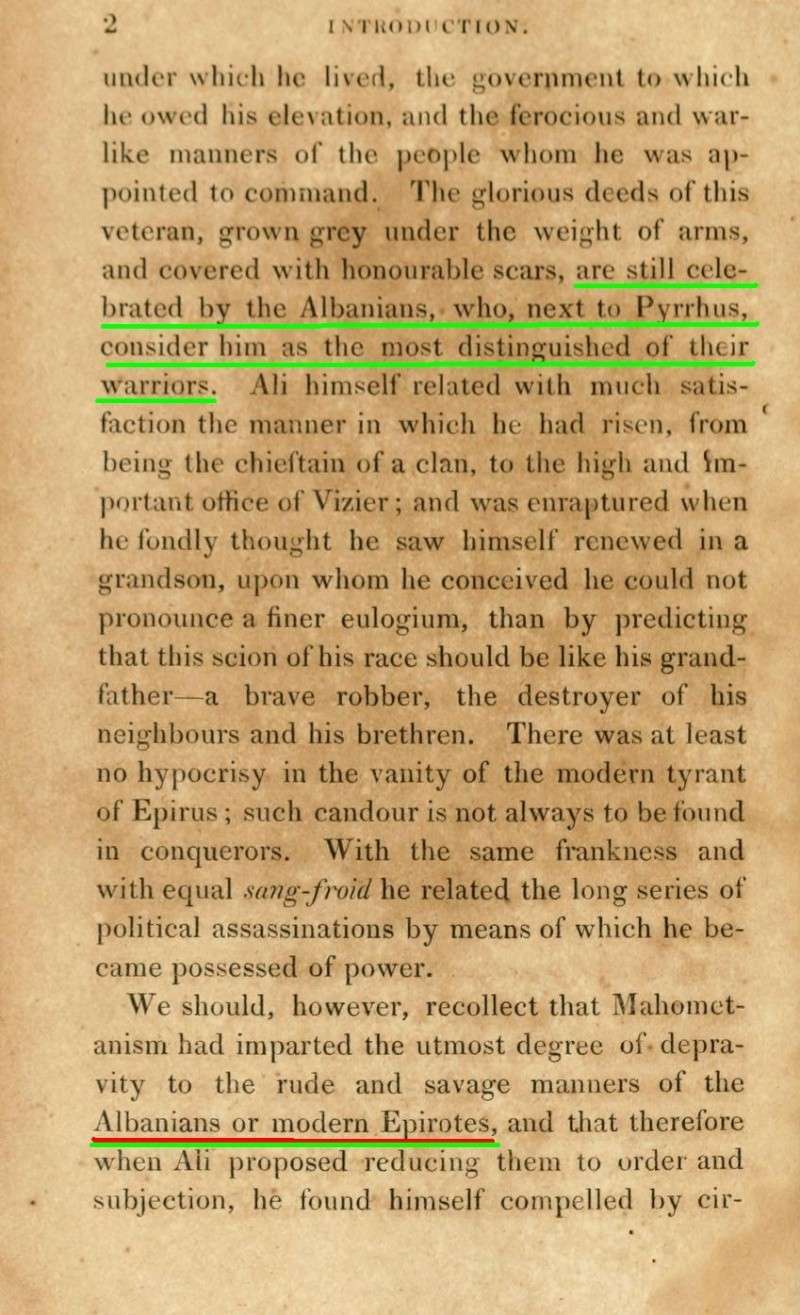The question of ethnicity of ancient and modern population of Epirus still continue to be object of dispute.Some scholars( historians, archaeologists ) argue that Epirotes were of Albanian descent,some other say that they were of greek origin.In the most part of ancient documents, the population of Epir was reckoned by all means as ‘barbarian’ also illyrian~epirotic~albanian.In the extreme south of Illyria (Epirus) there were several Hellenized Illyrian tribes such as the Chaoni,Thesproti and Molossi.According to Strabo by the time some Illyrian tribes, became bilingual through contact with their Greek neighbors.The 5th century BC Athenian historian Thucydides describes Epirotes as "barbarians", as does Strabo.Unlike most Greeks of this time, who lived in or around city-states, the inhabitants of Epirus lived in small villages and their way of life was foreign to that of the poleis of southern Greece. Their region lay on the periphery of the Greek world and was far from peaceful; for many centuries, it remained a frontier area contested with the Illyrian peoples to the north..The origin of the Albanians has been for some time a matter of dispute among historians. Most historians conclude that the Albanians are descendants of populations of the prehistoric Balkans, such as the Illyrians, Dacians or Thracians.Little is known about these peoples, and they blended into one another in Thraco-Illyrian and Daco-Thracian contact zones even in antiquity.
The Albanians first appear in the historical record in Byzantine sources of the late 11th century.It is during this time that an Albanian presence in Epirus is first mentioned. .At this point, they were already fully Christianized. Very little evidence of pre-Christian Albanian culture survives, although Albanian mythology and folklore are of Paleo-Balkanic origin and almost all of their elements are pagan.During this time Albanian clans seized most of the region and founded two local, short-lived entities, centered in Arta (1358–1416) and Gjirokastër (1386–1411) by the Losha and Zenebishi clans, respectively.Although Albanian clans gained control of most of the region of Epirus by the end of 15th century ,they were finally fully subdued by ottomans as it was the whole Balkan Penisula.


Documents;
-------------------------------------------------------------------------------

“The Helmet of Skanderbeg
Skanderbeg’s helmet is made of white metal, adorned with a strip dressed in gold. On its top lies the head of a horned goat made of bronze, also dressed in gold. The bottom part bears a copper strip adorned with a monogram separated by rosettes;
* IN * PE * RA * TO * RE BT *
which means:
Jhezus Nazarenus * Principi Emathie * Regi Albaniae * Terrori Osmanorum * Regi Epirotarum * Benedictat Te -
-Jesus Nazarene Blesses Thee [Skanderbeg], Prince of Mat, King of Albania, Terror of the Ottomans, King of Epirus.”
“From the Barbarians there were: 1000 Chaones witch had no King but 2 Prostates for 1 year Fotis and Nikanores. The Chaones are joint by Thesprotes wich have no King either. In the head of the Mollosians and the Atintanians was Sabylinthius, wich was the tutor of King Tharypa (yet still a child).There were also the Parauei with their King Oroides and 1000 Orestes.”
(~Thucydides, Peloponnesian War, . 2.80)
“…After the Epeirotes and the Illyrians, then, come the following peoples of the Greeks: the Acarnanians, the Aetolians, and the Ozolian Locrians…
~Strabo Geography Book VIII, Chapter 1, 1
And even to the present day the Thracians, Illyrians, and Epeirotes live on the flanks of the Greeks (though this was still more the case formerly than now); indeed most of the country that at the present time is indisputably Greece is held by the barbarians — Macedonia and certain parts of Thessaly by the Thracians, and the parts above Acarnania and Aetolia by the Thesproti, the Cassopaei, the Amphilochi, the Molossi, and the Athamanes — Epeirotic tribes.
~STRABO, GEOGRAPHY, Book VII, Chapter 7~
“Ephorus says that, if one begins with the western parts, Acarnania is the beginning of Greece; for, he adds, Acarnania is the first to border on the tribes of the Epeirotes. But just as Ephorus, using the sea-coast as his measuring-line, begins with Acarnania (for he decides in favour of the sea as a kind of guide in his description of places…so it is proper that I too, following the natural character of the regions, should make the sea my counsellor”.
~Strabo Geography Book VIII, Chapter 1, 3
Scylax notes that only beyond Ambracia, the Peneus and the town or mountain of Homotion in Magnesia, had the Greeks begun to inhabit the region in a compact manner.
1774 Johann Thunmann:
On the History and Language of the Albanians and Vlachs”
"In The North Adriatic lives the tribe of the Liburnians,
"The middle and the South Adriatic sea Is Populated By Illyrians"
"The Ionian sea is devided Between Chaons and Thesprots.Between them The Mollosians have opened an exit to the sea wich is (40 stadia=8Km)."
"After Mollosia it comes Ambracia an Hellenic Polis,which is (80 stadia) away from the sea"
"From there and down is Hellas no end"
~Scylax
The Greeks call those people Illyrians who occupy the region beyond Macedonia and Thrace from Chaonia and Thesprotia to the river Danube. This is the length of the country. Its breadth is from Macedonia and the mountains of Thrace to Pannonia and the Adriatic and the foothills of the Alps. Its breadth is five days' journey and its length thirty - so the Greek writers say. The Romans measured the country and found its length to be upward of 1,000 kilometers and its width about 220.
~Appian
"the Head(start) of Hellas, is Akarnania from the West,because it is the first that contacts with the Epirots tribes"
~Ephores
"Epirots speak a different language from the Greek,
it resembles very much to Macedonian"
~Strabo and Plutarchus
"The brave Epirots, the Albanians of antiquity, ...
~Theodor Mommsen








No comments:
Post a Comment